HLTH7004: Palliative Care: Reflective Essay on Quality of Life & Dying
VerifiedAdded on 2023/06/18
|10
|3490
|397
Essay
AI Summary
This essay provides a comprehensive analysis of the factors influencing the quality of life and dying in palliative care. It delves into environmental, stress-related, health-related, and social interaction factors impacting quality of life, as well as family support, the setting of death (home vs. hospital), and preparation for death affecting the dying process. The essay also reflects on legal aspects like euthanasia and advance care planning, cultural factors affecting living and dying (Arab and Filipino cultures), and religious approaches (Christianity and Hinduism). The student provides personal reflections and perspectives throughout, emphasizing the importance of understanding these diverse factors in providing holistic palliative care. The essay concludes by highlighting the interconnectedness of these elements in determining life contentment and satisfaction.
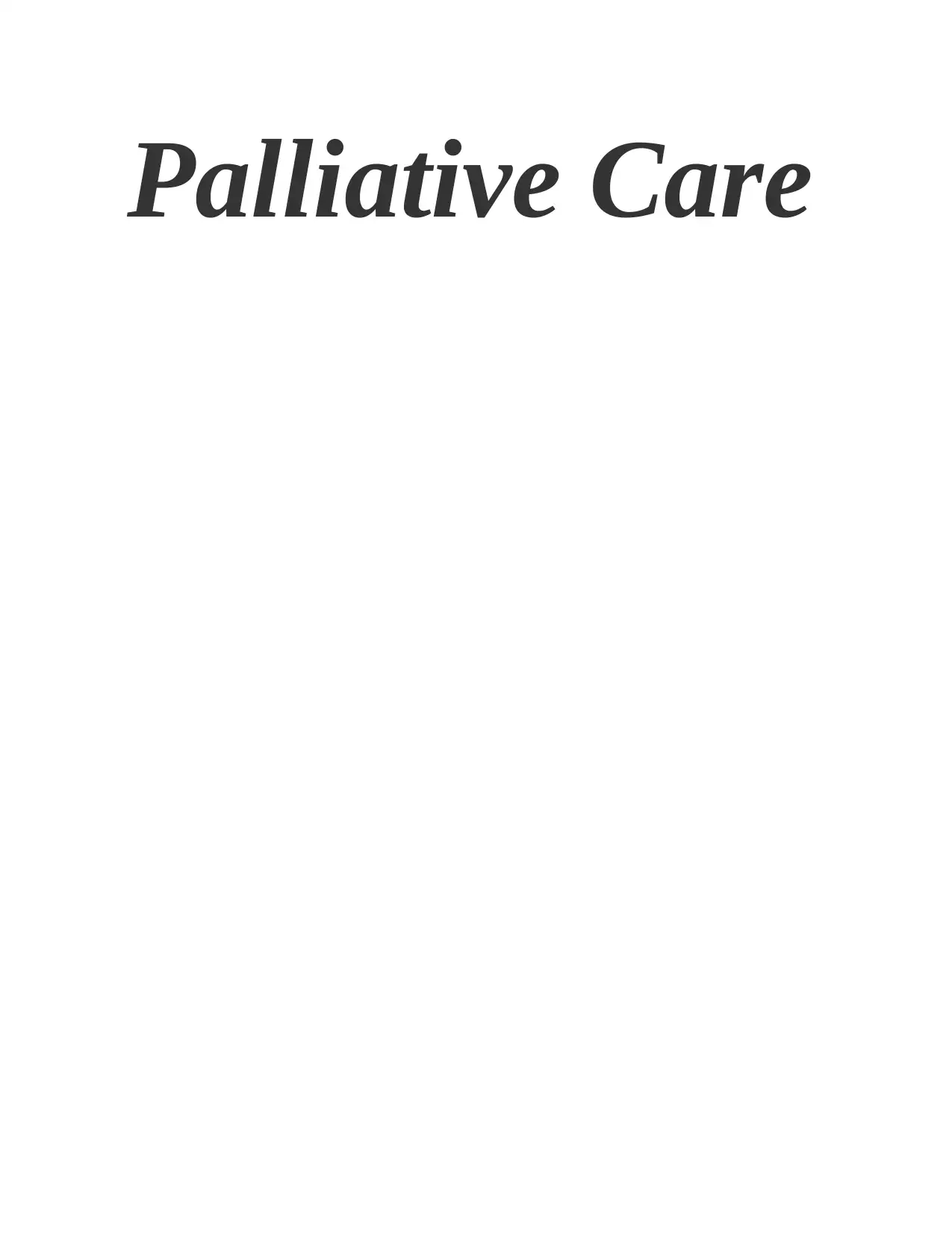
Palliative Care
Paraphrase This Document
Need a fresh take? Get an instant paraphrase of this document with our AI Paraphraser
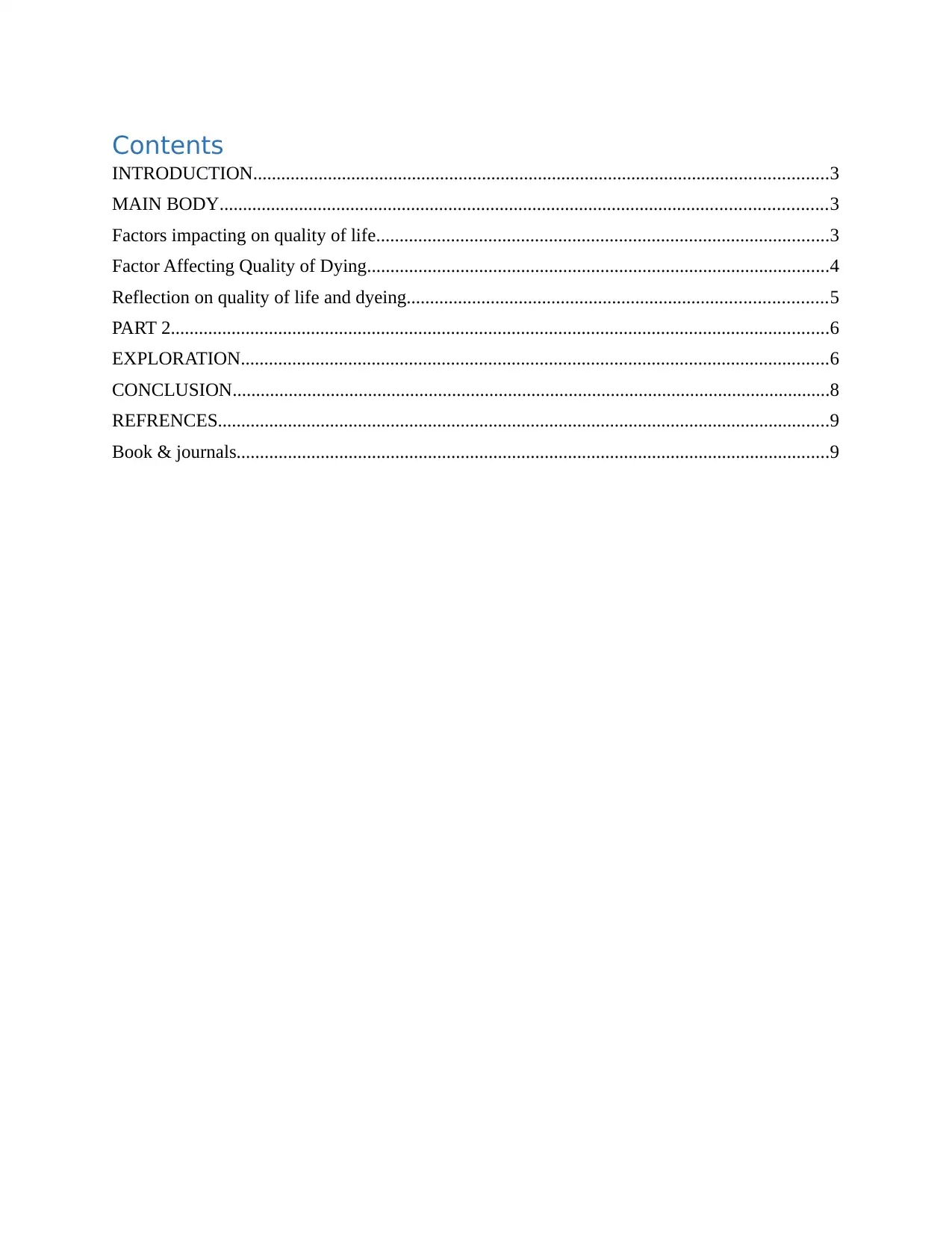
Contents
INTRODUCTION...........................................................................................................................3
MAIN BODY..................................................................................................................................3
Factors impacting on quality of life.................................................................................................3
Factor Affecting Quality of Dying...................................................................................................4
Reflection on quality of life and dyeing..........................................................................................5
PART 2.............................................................................................................................................6
EXPLORATION..............................................................................................................................6
CONCLUSION................................................................................................................................8
REFRENCES...................................................................................................................................9
Book & journals...............................................................................................................................9
INTRODUCTION...........................................................................................................................3
MAIN BODY..................................................................................................................................3
Factors impacting on quality of life.................................................................................................3
Factor Affecting Quality of Dying...................................................................................................4
Reflection on quality of life and dyeing..........................................................................................5
PART 2.............................................................................................................................................6
EXPLORATION..............................................................................................................................6
CONCLUSION................................................................................................................................8
REFRENCES...................................................................................................................................9
Book & journals...............................................................................................................................9
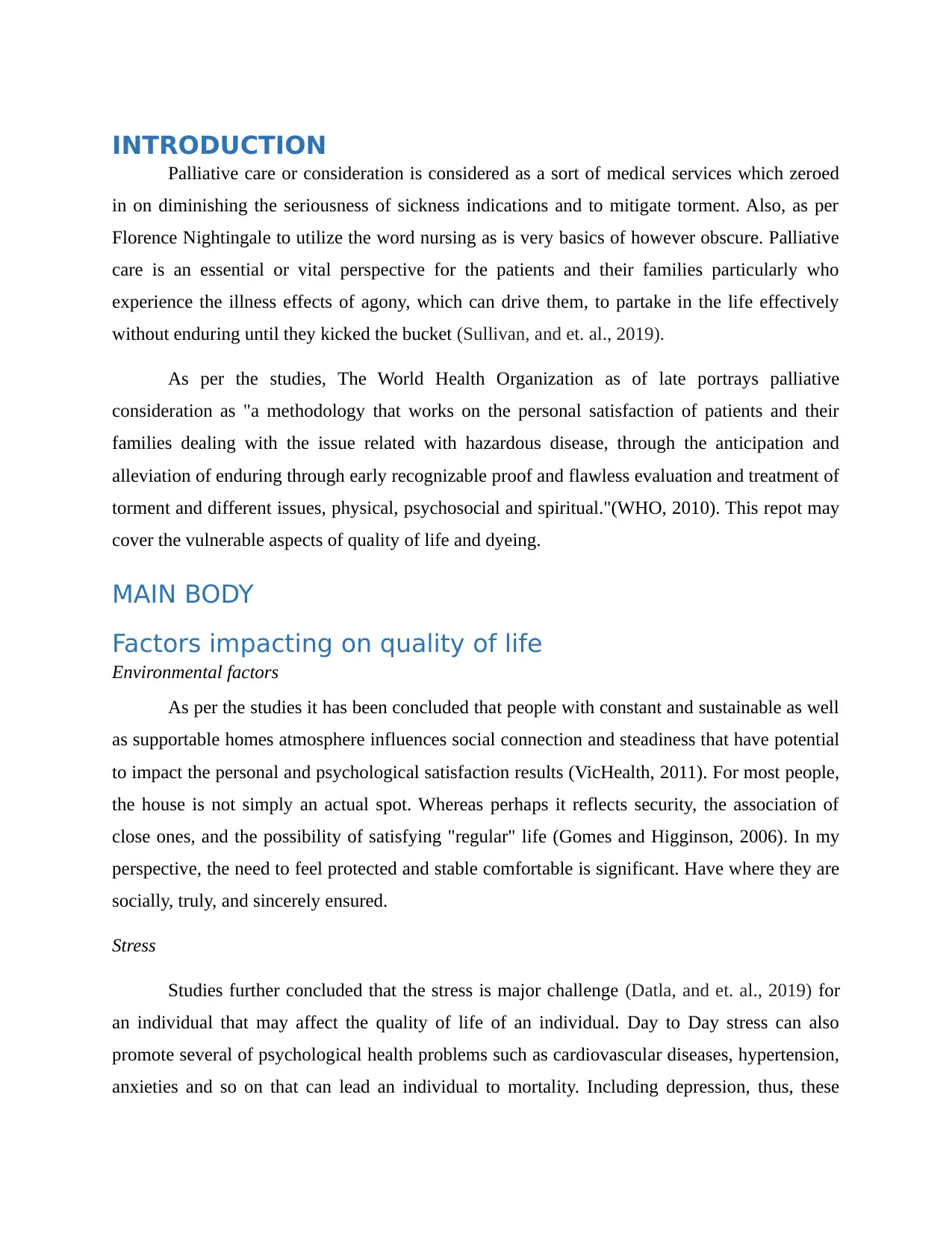
INTRODUCTION
Palliative care or consideration is considered as a sort of medical services which zeroed
in on diminishing the seriousness of sickness indications and to mitigate torment. Also, as per
Florence Nightingale to utilize the word nursing as is very basics of however obscure. Palliative
care is an essential or vital perspective for the patients and their families particularly who
experience the illness effects of agony, which can drive them, to partake in the life effectively
without enduring until they kicked the bucket (Sullivan, and et. al., 2019).
As per the studies, The World Health Organization as of late portrays palliative
consideration as "a methodology that works on the personal satisfaction of patients and their
families dealing with the issue related with hazardous disease, through the anticipation and
alleviation of enduring through early recognizable proof and flawless evaluation and treatment of
torment and different issues, physical, psychosocial and spiritual."(WHO, 2010). This repot may
cover the vulnerable aspects of quality of life and dyeing.
MAIN BODY
Factors impacting on quality of life
Environmental factors
As per the studies it has been concluded that people with constant and sustainable as well
as supportable homes atmosphere influences social connection and steadiness that have potential
to impact the personal and psychological satisfaction results (VicHealth, 2011). For most people,
the house is not simply an actual spot. Whereas perhaps it reflects security, the association of
close ones, and the possibility of satisfying "regular" life (Gomes and Higginson, 2006). In my
perspective, the need to feel protected and stable comfortable is significant. Have where they are
socially, truly, and sincerely ensured.
Stress
Studies further concluded that the stress is major challenge (Datla, and et. al., 2019) for
an individual that may affect the quality of life of an individual. Day to Day stress can also
promote several of psychological health problems such as cardiovascular diseases, hypertension,
anxieties and so on that can lead an individual to mortality. Including depression, thus, these
Palliative care or consideration is considered as a sort of medical services which zeroed
in on diminishing the seriousness of sickness indications and to mitigate torment. Also, as per
Florence Nightingale to utilize the word nursing as is very basics of however obscure. Palliative
care is an essential or vital perspective for the patients and their families particularly who
experience the illness effects of agony, which can drive them, to partake in the life effectively
without enduring until they kicked the bucket (Sullivan, and et. al., 2019).
As per the studies, The World Health Organization as of late portrays palliative
consideration as "a methodology that works on the personal satisfaction of patients and their
families dealing with the issue related with hazardous disease, through the anticipation and
alleviation of enduring through early recognizable proof and flawless evaluation and treatment of
torment and different issues, physical, psychosocial and spiritual."(WHO, 2010). This repot may
cover the vulnerable aspects of quality of life and dyeing.
MAIN BODY
Factors impacting on quality of life
Environmental factors
As per the studies it has been concluded that people with constant and sustainable as well
as supportable homes atmosphere influences social connection and steadiness that have potential
to impact the personal and psychological satisfaction results (VicHealth, 2011). For most people,
the house is not simply an actual spot. Whereas perhaps it reflects security, the association of
close ones, and the possibility of satisfying "regular" life (Gomes and Higginson, 2006). In my
perspective, the need to feel protected and stable comfortable is significant. Have where they are
socially, truly, and sincerely ensured.
Stress
Studies further concluded that the stress is major challenge (Datla, and et. al., 2019) for
an individual that may affect the quality of life of an individual. Day to Day stress can also
promote several of psychological health problems such as cardiovascular diseases, hypertension,
anxieties and so on that can lead an individual to mortality. Including depression, thus, these
⊘ This is a preview!⊘
Do you want full access?
Subscribe today to unlock all pages.

Trusted by 1+ million students worldwide
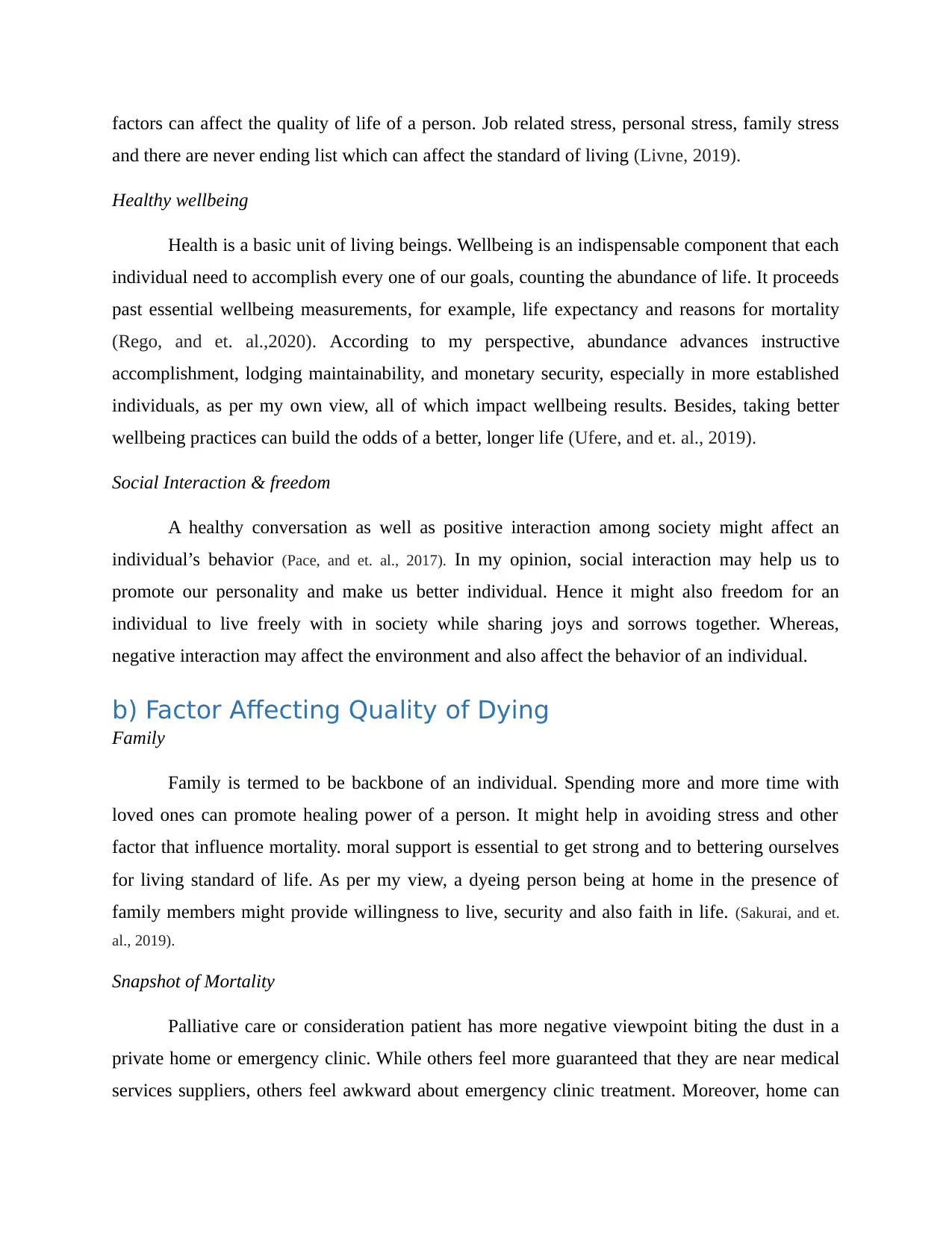
factors can affect the quality of life of a person. Job related stress, personal stress, family stress
and there are never ending list which can affect the standard of living (Livne, 2019).
Healthy wellbeing
Health is a basic unit of living beings. Wellbeing is an indispensable component that each
individual need to accomplish every one of our goals, counting the abundance of life. It proceeds
past essential wellbeing measurements, for example, life expectancy and reasons for mortality
(Rego, and et. al.,2020). According to my perspective, abundance advances instructive
accomplishment, lodging maintainability, and monetary security, especially in more established
individuals, as per my own view, all of which impact wellbeing results. Besides, taking better
wellbeing practices can build the odds of a better, longer life (Ufere, and et. al., 2019).
Social Interaction & freedom
A healthy conversation as well as positive interaction among society might affect an
individual’s behavior (Pace, and et. al., 2017). In my opinion, social interaction may help us to
promote our personality and make us better individual. Hence it might also freedom for an
individual to live freely with in society while sharing joys and sorrows together. Whereas,
negative interaction may affect the environment and also affect the behavior of an individual.
b) Factor Affecting Quality of Dying
Family
Family is termed to be backbone of an individual. Spending more and more time with
loved ones can promote healing power of a person. It might help in avoiding stress and other
factor that influence mortality. moral support is essential to get strong and to bettering ourselves
for living standard of life. As per my view, a dyeing person being at home in the presence of
family members might provide willingness to live, security and also faith in life. (Sakurai, and et.
al., 2019).
Snapshot of Mortality
Palliative care or consideration patient has more negative viewpoint biting the dust in a
private home or emergency clinic. While others feel more guaranteed that they are near medical
services suppliers, others feel awkward about emergency clinic treatment. Moreover, home can
and there are never ending list which can affect the standard of living (Livne, 2019).
Healthy wellbeing
Health is a basic unit of living beings. Wellbeing is an indispensable component that each
individual need to accomplish every one of our goals, counting the abundance of life. It proceeds
past essential wellbeing measurements, for example, life expectancy and reasons for mortality
(Rego, and et. al.,2020). According to my perspective, abundance advances instructive
accomplishment, lodging maintainability, and monetary security, especially in more established
individuals, as per my own view, all of which impact wellbeing results. Besides, taking better
wellbeing practices can build the odds of a better, longer life (Ufere, and et. al., 2019).
Social Interaction & freedom
A healthy conversation as well as positive interaction among society might affect an
individual’s behavior (Pace, and et. al., 2017). In my opinion, social interaction may help us to
promote our personality and make us better individual. Hence it might also freedom for an
individual to live freely with in society while sharing joys and sorrows together. Whereas,
negative interaction may affect the environment and also affect the behavior of an individual.
b) Factor Affecting Quality of Dying
Family
Family is termed to be backbone of an individual. Spending more and more time with
loved ones can promote healing power of a person. It might help in avoiding stress and other
factor that influence mortality. moral support is essential to get strong and to bettering ourselves
for living standard of life. As per my view, a dyeing person being at home in the presence of
family members might provide willingness to live, security and also faith in life. (Sakurai, and et.
al., 2019).
Snapshot of Mortality
Palliative care or consideration patient has more negative viewpoint biting the dust in a
private home or emergency clinic. While others feel more guaranteed that they are near medical
services suppliers, others feel awkward about emergency clinic treatment. Moreover, home can
Paraphrase This Document
Need a fresh take? Get an instant paraphrase of this document with our AI Paraphraser
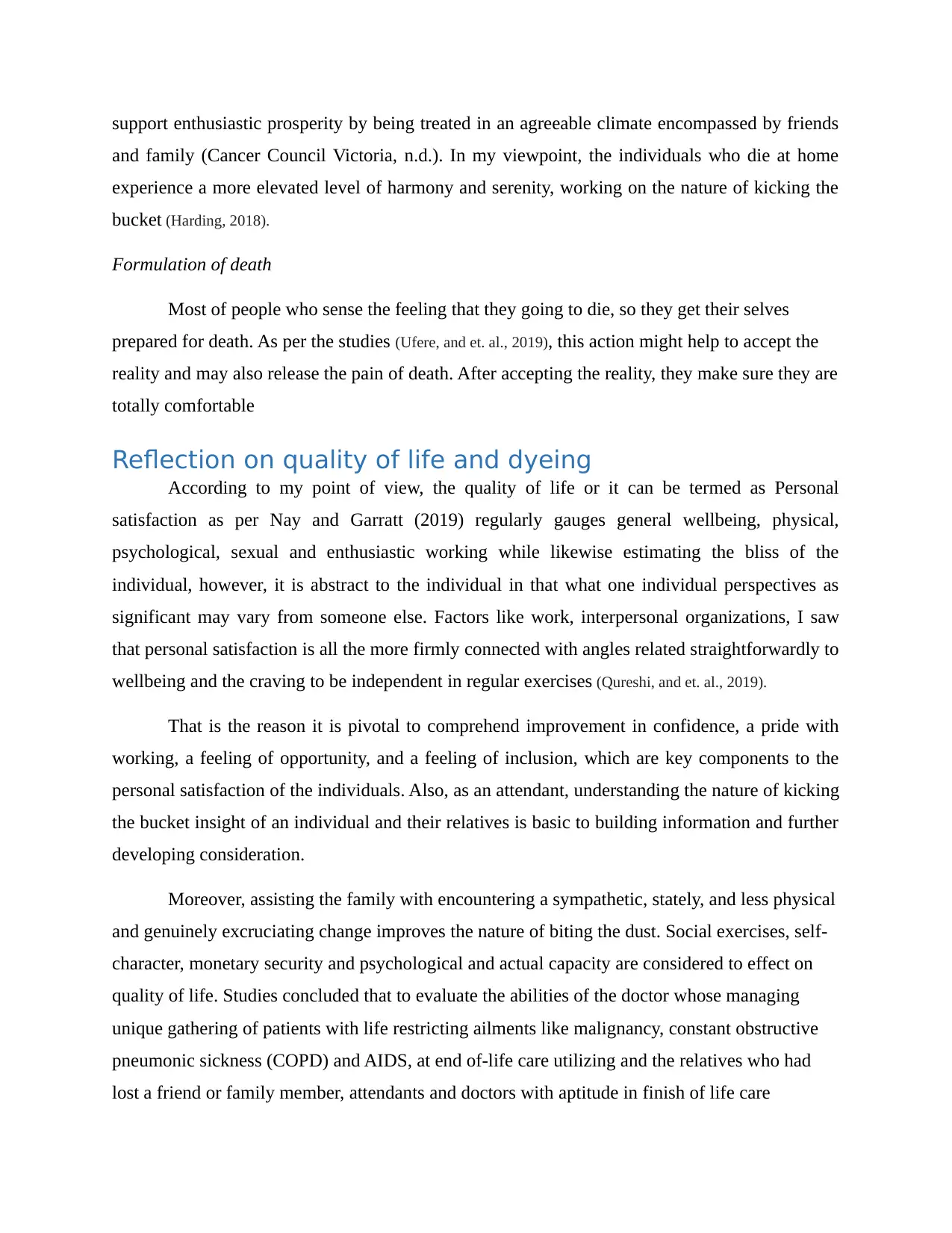
support enthusiastic prosperity by being treated in an agreeable climate encompassed by friends
and family (Cancer Council Victoria, n.d.). In my viewpoint, the individuals who die at home
experience a more elevated level of harmony and serenity, working on the nature of kicking the
bucket (Harding, 2018).
Formulation of death
Most of people who sense the feeling that they going to die, so they get their selves
prepared for death. As per the studies (Ufere, and et. al., 2019), this action might help to accept the
reality and may also release the pain of death. After accepting the reality, they make sure they are
totally comfortable
Reflection on quality of life and dyeing
According to my point of view, the quality of life or it can be termed as Personal
satisfaction as per Nay and Garratt (2019) regularly gauges general wellbeing, physical,
psychological, sexual and enthusiastic working while likewise estimating the bliss of the
individual, however, it is abstract to the individual in that what one individual perspectives as
significant may vary from someone else. Factors like work, interpersonal organizations, I saw
that personal satisfaction is all the more firmly connected with angles related straightforwardly to
wellbeing and the craving to be independent in regular exercises (Qureshi, and et. al., 2019).
That is the reason it is pivotal to comprehend improvement in confidence, a pride with
working, a feeling of opportunity, and a feeling of inclusion, which are key components to the
personal satisfaction of the individuals. Also, as an attendant, understanding the nature of kicking
the bucket insight of an individual and their relatives is basic to building information and further
developing consideration.
Moreover, assisting the family with encountering a sympathetic, stately, and less physical
and genuinely excruciating change improves the nature of biting the dust. Social exercises, self-
character, monetary security and psychological and actual capacity are considered to effect on
quality of life. Studies concluded that to evaluate the abilities of the doctor whose managing
unique gathering of patients with life restricting ailments like malignancy, constant obstructive
pneumonic sickness (COPD) and AIDS, at end of-life care utilizing and the relatives who had
lost a friend or family member, attendants and doctors with aptitude in finish of life care
and family (Cancer Council Victoria, n.d.). In my viewpoint, the individuals who die at home
experience a more elevated level of harmony and serenity, working on the nature of kicking the
bucket (Harding, 2018).
Formulation of death
Most of people who sense the feeling that they going to die, so they get their selves
prepared for death. As per the studies (Ufere, and et. al., 2019), this action might help to accept the
reality and may also release the pain of death. After accepting the reality, they make sure they are
totally comfortable
Reflection on quality of life and dyeing
According to my point of view, the quality of life or it can be termed as Personal
satisfaction as per Nay and Garratt (2019) regularly gauges general wellbeing, physical,
psychological, sexual and enthusiastic working while likewise estimating the bliss of the
individual, however, it is abstract to the individual in that what one individual perspectives as
significant may vary from someone else. Factors like work, interpersonal organizations, I saw
that personal satisfaction is all the more firmly connected with angles related straightforwardly to
wellbeing and the craving to be independent in regular exercises (Qureshi, and et. al., 2019).
That is the reason it is pivotal to comprehend improvement in confidence, a pride with
working, a feeling of opportunity, and a feeling of inclusion, which are key components to the
personal satisfaction of the individuals. Also, as an attendant, understanding the nature of kicking
the bucket insight of an individual and their relatives is basic to building information and further
developing consideration.
Moreover, assisting the family with encountering a sympathetic, stately, and less physical
and genuinely excruciating change improves the nature of biting the dust. Social exercises, self-
character, monetary security and psychological and actual capacity are considered to effect on
quality of life. Studies concluded that to evaluate the abilities of the doctor whose managing
unique gathering of patients with life restricting ailments like malignancy, constant obstructive
pneumonic sickness (COPD) and AIDS, at end of-life care utilizing and the relatives who had
lost a friend or family member, attendants and doctors with aptitude in finish of life care
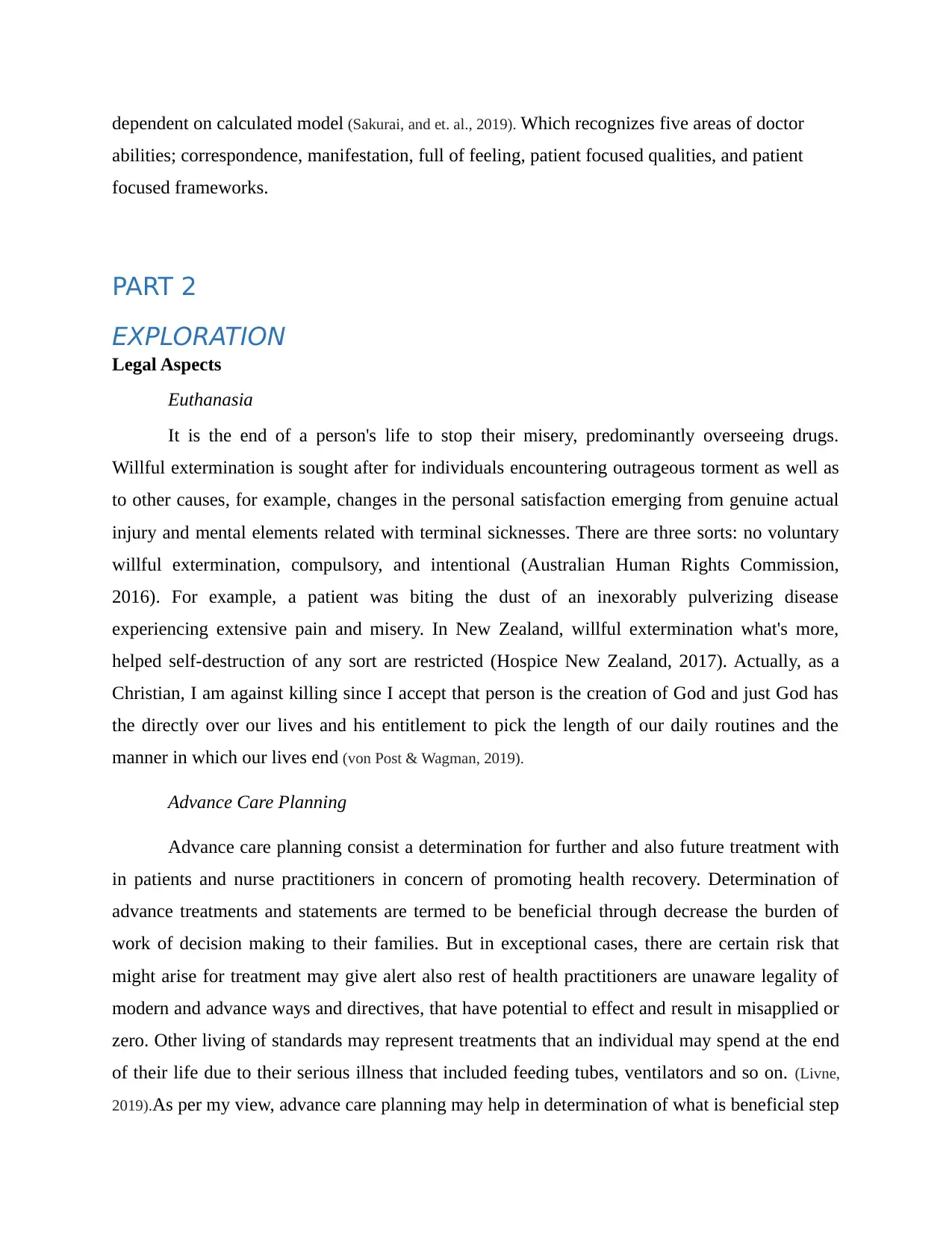
dependent on calculated model (Sakurai, and et. al., 2019). Which recognizes five areas of doctor
abilities; correspondence, manifestation, full of feeling, patient focused qualities, and patient
focused frameworks.
PART 2
EXPLORATION
Legal Aspects
Euthanasia
It is the end of a person's life to stop their misery, predominantly overseeing drugs.
Willful extermination is sought after for individuals encountering outrageous torment as well as
to other causes, for example, changes in the personal satisfaction emerging from genuine actual
injury and mental elements related with terminal sicknesses. There are three sorts: no voluntary
willful extermination, compulsory, and intentional (Australian Human Rights Commission,
2016). For example, a patient was biting the dust of an inexorably pulverizing disease
experiencing extensive pain and misery. In New Zealand, willful extermination what's more,
helped self-destruction of any sort are restricted (Hospice New Zealand, 2017). Actually, as a
Christian, I am against killing since I accept that person is the creation of God and just God has
the directly over our lives and his entitlement to pick the length of our daily routines and the
manner in which our lives end (von Post & Wagman, 2019).
Advance Care Planning
Advance care planning consist a determination for further and also future treatment with
in patients and nurse practitioners in concern of promoting health recovery. Determination of
advance treatments and statements are termed to be beneficial through decrease the burden of
work of decision making to their families. But in exceptional cases, there are certain risk that
might arise for treatment may give alert also rest of health practitioners are unaware legality of
modern and advance ways and directives, that have potential to effect and result in misapplied or
zero. Other living of standards may represent treatments that an individual may spend at the end
of their life due to their serious illness that included feeding tubes, ventilators and so on. (Livne,
2019).As per my view, advance care planning may help in determination of what is beneficial step
abilities; correspondence, manifestation, full of feeling, patient focused qualities, and patient
focused frameworks.
PART 2
EXPLORATION
Legal Aspects
Euthanasia
It is the end of a person's life to stop their misery, predominantly overseeing drugs.
Willful extermination is sought after for individuals encountering outrageous torment as well as
to other causes, for example, changes in the personal satisfaction emerging from genuine actual
injury and mental elements related with terminal sicknesses. There are three sorts: no voluntary
willful extermination, compulsory, and intentional (Australian Human Rights Commission,
2016). For example, a patient was biting the dust of an inexorably pulverizing disease
experiencing extensive pain and misery. In New Zealand, willful extermination what's more,
helped self-destruction of any sort are restricted (Hospice New Zealand, 2017). Actually, as a
Christian, I am against killing since I accept that person is the creation of God and just God has
the directly over our lives and his entitlement to pick the length of our daily routines and the
manner in which our lives end (von Post & Wagman, 2019).
Advance Care Planning
Advance care planning consist a determination for further and also future treatment with
in patients and nurse practitioners in concern of promoting health recovery. Determination of
advance treatments and statements are termed to be beneficial through decrease the burden of
work of decision making to their families. But in exceptional cases, there are certain risk that
might arise for treatment may give alert also rest of health practitioners are unaware legality of
modern and advance ways and directives, that have potential to effect and result in misapplied or
zero. Other living of standards may represent treatments that an individual may spend at the end
of their life due to their serious illness that included feeding tubes, ventilators and so on. (Livne,
2019).As per my view, advance care planning may help in determination of what is beneficial step
⊘ This is a preview!⊘
Do you want full access?
Subscribe today to unlock all pages.

Trusted by 1+ million students worldwide
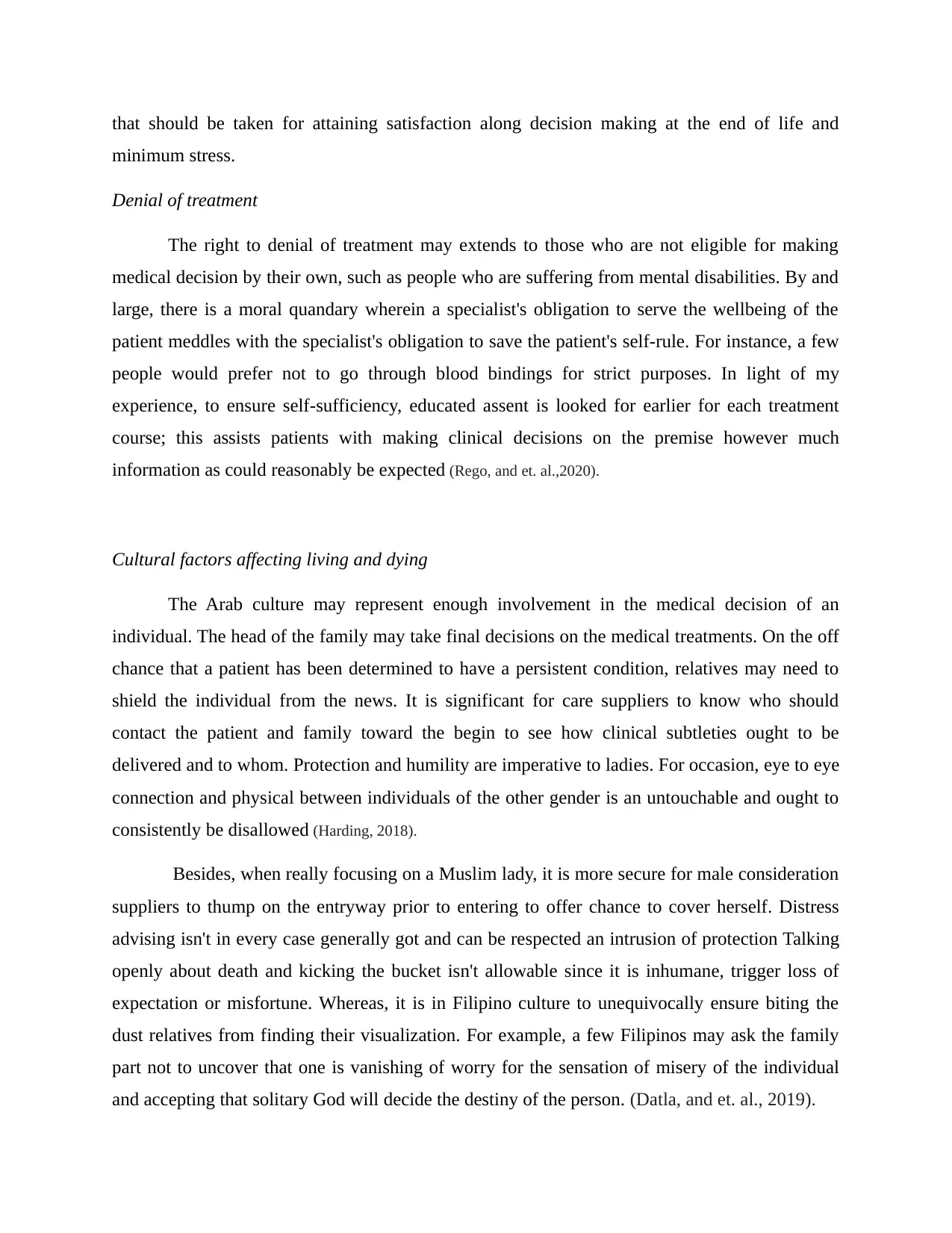
that should be taken for attaining satisfaction along decision making at the end of life and
minimum stress.
Denial of treatment
The right to denial of treatment may extends to those who are not eligible for making
medical decision by their own, such as people who are suffering from mental disabilities. By and
large, there is a moral quandary wherein a specialist's obligation to serve the wellbeing of the
patient meddles with the specialist's obligation to save the patient's self-rule. For instance, a few
people would prefer not to go through blood bindings for strict purposes. In light of my
experience, to ensure self-sufficiency, educated assent is looked for earlier for each treatment
course; this assists patients with making clinical decisions on the premise however much
information as could reasonably be expected (Rego, and et. al.,2020).
Cultural factors affecting living and dying
The Arab culture may represent enough involvement in the medical decision of an
individual. The head of the family may take final decisions on the medical treatments. On the off
chance that a patient has been determined to have a persistent condition, relatives may need to
shield the individual from the news. It is significant for care suppliers to know who should
contact the patient and family toward the begin to see how clinical subtleties ought to be
delivered and to whom. Protection and humility are imperative to ladies. For occasion, eye to eye
connection and physical between individuals of the other gender is an untouchable and ought to
consistently be disallowed (Harding, 2018).
Besides, when really focusing on a Muslim lady, it is more secure for male consideration
suppliers to thump on the entryway prior to entering to offer chance to cover herself. Distress
advising isn't in every case generally got and can be respected an intrusion of protection Talking
openly about death and kicking the bucket isn't allowable since it is inhumane, trigger loss of
expectation or misfortune. Whereas, it is in Filipino culture to unequivocally ensure biting the
dust relatives from finding their visualization. For example, a few Filipinos may ask the family
part not to uncover that one is vanishing of worry for the sensation of misery of the individual
and accepting that solitary God will decide the destiny of the person. (Datla, and et. al., 2019).
minimum stress.
Denial of treatment
The right to denial of treatment may extends to those who are not eligible for making
medical decision by their own, such as people who are suffering from mental disabilities. By and
large, there is a moral quandary wherein a specialist's obligation to serve the wellbeing of the
patient meddles with the specialist's obligation to save the patient's self-rule. For instance, a few
people would prefer not to go through blood bindings for strict purposes. In light of my
experience, to ensure self-sufficiency, educated assent is looked for earlier for each treatment
course; this assists patients with making clinical decisions on the premise however much
information as could reasonably be expected (Rego, and et. al.,2020).
Cultural factors affecting living and dying
The Arab culture may represent enough involvement in the medical decision of an
individual. The head of the family may take final decisions on the medical treatments. On the off
chance that a patient has been determined to have a persistent condition, relatives may need to
shield the individual from the news. It is significant for care suppliers to know who should
contact the patient and family toward the begin to see how clinical subtleties ought to be
delivered and to whom. Protection and humility are imperative to ladies. For occasion, eye to eye
connection and physical between individuals of the other gender is an untouchable and ought to
consistently be disallowed (Harding, 2018).
Besides, when really focusing on a Muslim lady, it is more secure for male consideration
suppliers to thump on the entryway prior to entering to offer chance to cover herself. Distress
advising isn't in every case generally got and can be respected an intrusion of protection Talking
openly about death and kicking the bucket isn't allowable since it is inhumane, trigger loss of
expectation or misfortune. Whereas, it is in Filipino culture to unequivocally ensure biting the
dust relatives from finding their visualization. For example, a few Filipinos may ask the family
part not to uncover that one is vanishing of worry for the sensation of misery of the individual
and accepting that solitary God will decide the destiny of the person. (Datla, and et. al., 2019).
Paraphrase This Document
Need a fresh take? Get an instant paraphrase of this document with our AI Paraphraser
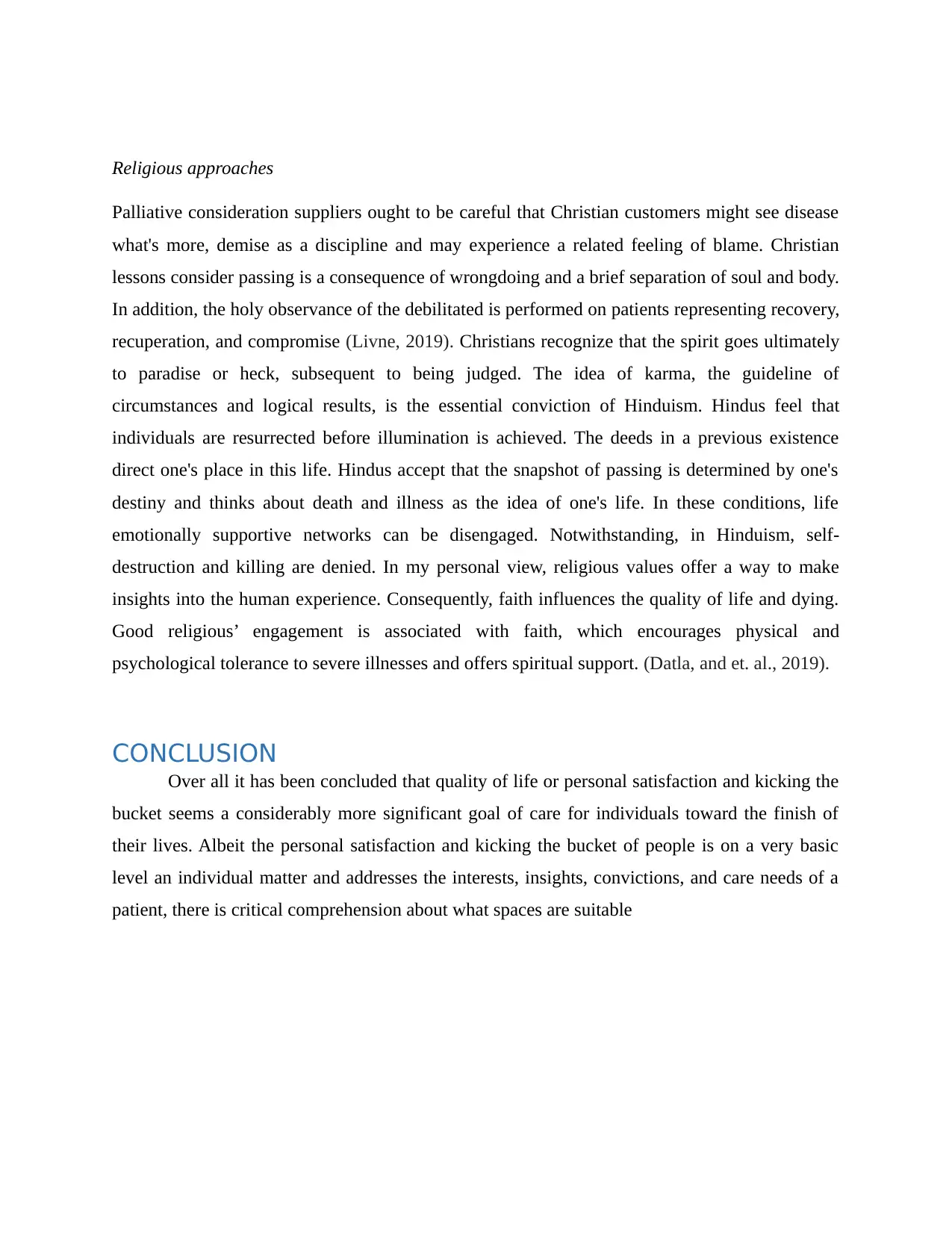
Religious approaches
Palliative consideration suppliers ought to be careful that Christian customers might see disease
what's more, demise as a discipline and may experience a related feeling of blame. Christian
lessons consider passing is a consequence of wrongdoing and a brief separation of soul and body.
In addition, the holy observance of the debilitated is performed on patients representing recovery,
recuperation, and compromise (Livne, 2019). Christians recognize that the spirit goes ultimately
to paradise or heck, subsequent to being judged. The idea of karma, the guideline of
circumstances and logical results, is the essential conviction of Hinduism. Hindus feel that
individuals are resurrected before illumination is achieved. The deeds in a previous existence
direct one's place in this life. Hindus accept that the snapshot of passing is determined by one's
destiny and thinks about death and illness as the idea of one's life. In these conditions, life
emotionally supportive networks can be disengaged. Notwithstanding, in Hinduism, self-
destruction and killing are denied. In my personal view, religious values offer a way to make
insights into the human experience. Consequently, faith influences the quality of life and dying.
Good religious’ engagement is associated with faith, which encourages physical and
psychological tolerance to severe illnesses and offers spiritual support. (Datla, and et. al., 2019).
CONCLUSION
Over all it has been concluded that quality of life or personal satisfaction and kicking the
bucket seems a considerably more significant goal of care for individuals toward the finish of
their lives. Albeit the personal satisfaction and kicking the bucket of people is on a very basic
level an individual matter and addresses the interests, insights, convictions, and care needs of a
patient, there is critical comprehension about what spaces are suitable
Palliative consideration suppliers ought to be careful that Christian customers might see disease
what's more, demise as a discipline and may experience a related feeling of blame. Christian
lessons consider passing is a consequence of wrongdoing and a brief separation of soul and body.
In addition, the holy observance of the debilitated is performed on patients representing recovery,
recuperation, and compromise (Livne, 2019). Christians recognize that the spirit goes ultimately
to paradise or heck, subsequent to being judged. The idea of karma, the guideline of
circumstances and logical results, is the essential conviction of Hinduism. Hindus feel that
individuals are resurrected before illumination is achieved. The deeds in a previous existence
direct one's place in this life. Hindus accept that the snapshot of passing is determined by one's
destiny and thinks about death and illness as the idea of one's life. In these conditions, life
emotionally supportive networks can be disengaged. Notwithstanding, in Hinduism, self-
destruction and killing are denied. In my personal view, religious values offer a way to make
insights into the human experience. Consequently, faith influences the quality of life and dying.
Good religious’ engagement is associated with faith, which encourages physical and
psychological tolerance to severe illnesses and offers spiritual support. (Datla, and et. al., 2019).
CONCLUSION
Over all it has been concluded that quality of life or personal satisfaction and kicking the
bucket seems a considerably more significant goal of care for individuals toward the finish of
their lives. Albeit the personal satisfaction and kicking the bucket of people is on a very basic
level an individual matter and addresses the interests, insights, convictions, and care needs of a
patient, there is critical comprehension about what spaces are suitable
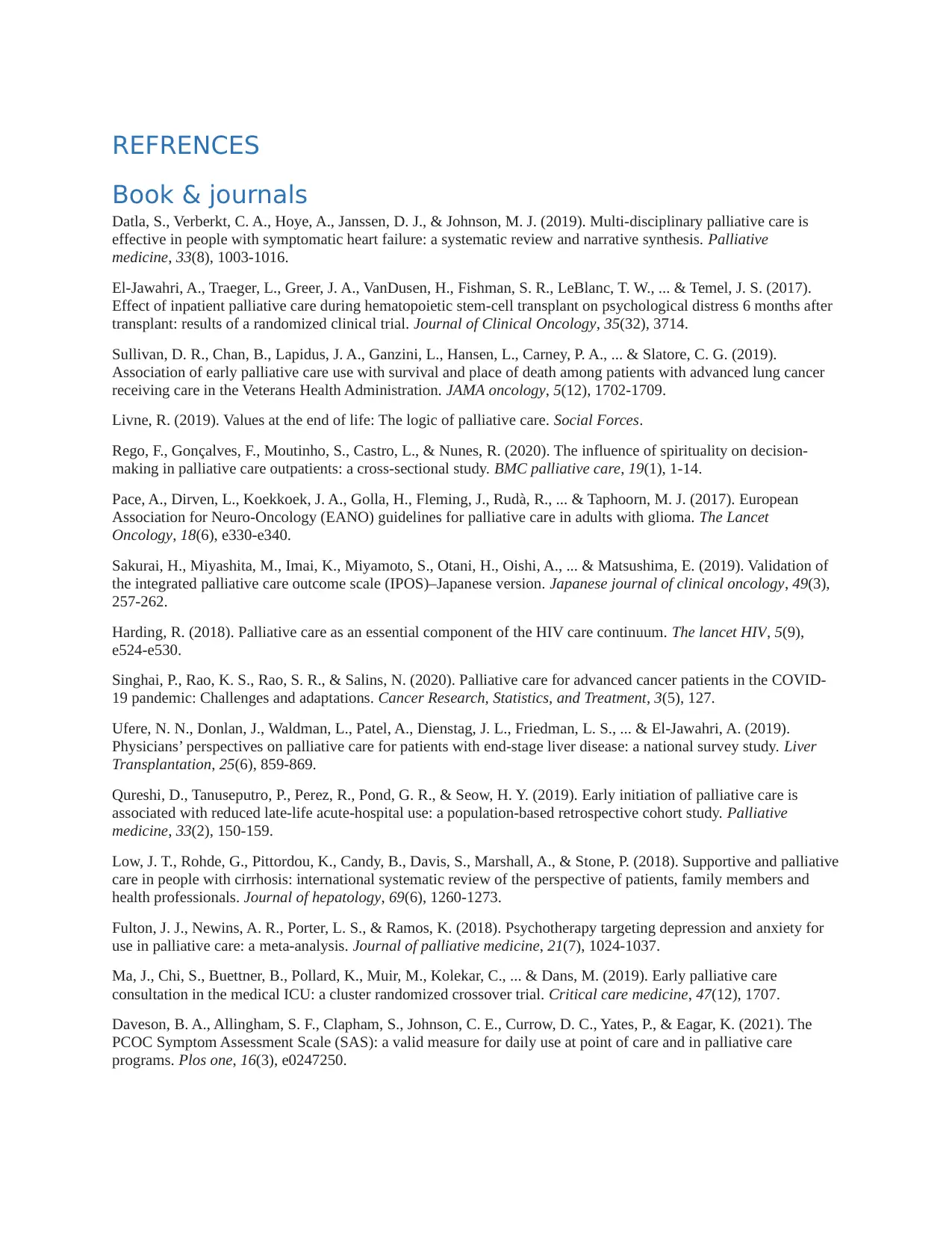
REFRENCES
Book & journals
Datla, S., Verberkt, C. A., Hoye, A., Janssen, D. J., & Johnson, M. J. (2019). Multi-disciplinary palliative care is
effective in people with symptomatic heart failure: a systematic review and narrative synthesis. Palliative
medicine, 33(8), 1003-1016.
El-Jawahri, A., Traeger, L., Greer, J. A., VanDusen, H., Fishman, S. R., LeBlanc, T. W., ... & Temel, J. S. (2017).
Effect of inpatient palliative care during hematopoietic stem-cell transplant on psychological distress 6 months after
transplant: results of a randomized clinical trial. Journal of Clinical Oncology, 35(32), 3714.
Sullivan, D. R., Chan, B., Lapidus, J. A., Ganzini, L., Hansen, L., Carney, P. A., ... & Slatore, C. G. (2019).
Association of early palliative care use with survival and place of death among patients with advanced lung cancer
receiving care in the Veterans Health Administration. JAMA oncology, 5(12), 1702-1709.
Livne, R. (2019). Values at the end of life: The logic of palliative care. Social Forces.
Rego, F., Gonçalves, F., Moutinho, S., Castro, L., & Nunes, R. (2020). The influence of spirituality on decision-
making in palliative care outpatients: a cross-sectional study. BMC palliative care, 19(1), 1-14.
Pace, A., Dirven, L., Koekkoek, J. A., Golla, H., Fleming, J., Rudà, R., ... & Taphoorn, M. J. (2017). European
Association for Neuro-Oncology (EANO) guidelines for palliative care in adults with glioma. The Lancet
Oncology, 18(6), e330-e340.
Sakurai, H., Miyashita, M., Imai, K., Miyamoto, S., Otani, H., Oishi, A., ... & Matsushima, E. (2019). Validation of
the integrated palliative care outcome scale (IPOS)–Japanese version. Japanese journal of clinical oncology, 49(3),
257-262.
Harding, R. (2018). Palliative care as an essential component of the HIV care continuum. The lancet HIV, 5(9),
e524-e530.
Singhai, P., Rao, K. S., Rao, S. R., & Salins, N. (2020). Palliative care for advanced cancer patients in the COVID-
19 pandemic: Challenges and adaptations. Cancer Research, Statistics, and Treatment, 3(5), 127.
Ufere, N. N., Donlan, J., Waldman, L., Patel, A., Dienstag, J. L., Friedman, L. S., ... & El‐Jawahri, A. (2019).
Physicians’ perspectives on palliative care for patients with end‐stage liver disease: a national survey study. Liver
Transplantation, 25(6), 859-869.
Qureshi, D., Tanuseputro, P., Perez, R., Pond, G. R., & Seow, H. Y. (2019). Early initiation of palliative care is
associated with reduced late-life acute-hospital use: a population-based retrospective cohort study. Palliative
medicine, 33(2), 150-159.
Low, J. T., Rohde, G., Pittordou, K., Candy, B., Davis, S., Marshall, A., & Stone, P. (2018). Supportive and palliative
care in people with cirrhosis: international systematic review of the perspective of patients, family members and
health professionals. Journal of hepatology, 69(6), 1260-1273.
Fulton, J. J., Newins, A. R., Porter, L. S., & Ramos, K. (2018). Psychotherapy targeting depression and anxiety for
use in palliative care: a meta-analysis. Journal of palliative medicine, 21(7), 1024-1037.
Ma, J., Chi, S., Buettner, B., Pollard, K., Muir, M., Kolekar, C., ... & Dans, M. (2019). Early palliative care
consultation in the medical ICU: a cluster randomized crossover trial. Critical care medicine, 47(12), 1707.
Daveson, B. A., Allingham, S. F., Clapham, S., Johnson, C. E., Currow, D. C., Yates, P., & Eagar, K. (2021). The
PCOC Symptom Assessment Scale (SAS): a valid measure for daily use at point of care and in palliative care
programs. Plos one, 16(3), e0247250.
Book & journals
Datla, S., Verberkt, C. A., Hoye, A., Janssen, D. J., & Johnson, M. J. (2019). Multi-disciplinary palliative care is
effective in people with symptomatic heart failure: a systematic review and narrative synthesis. Palliative
medicine, 33(8), 1003-1016.
El-Jawahri, A., Traeger, L., Greer, J. A., VanDusen, H., Fishman, S. R., LeBlanc, T. W., ... & Temel, J. S. (2017).
Effect of inpatient palliative care during hematopoietic stem-cell transplant on psychological distress 6 months after
transplant: results of a randomized clinical trial. Journal of Clinical Oncology, 35(32), 3714.
Sullivan, D. R., Chan, B., Lapidus, J. A., Ganzini, L., Hansen, L., Carney, P. A., ... & Slatore, C. G. (2019).
Association of early palliative care use with survival and place of death among patients with advanced lung cancer
receiving care in the Veterans Health Administration. JAMA oncology, 5(12), 1702-1709.
Livne, R. (2019). Values at the end of life: The logic of palliative care. Social Forces.
Rego, F., Gonçalves, F., Moutinho, S., Castro, L., & Nunes, R. (2020). The influence of spirituality on decision-
making in palliative care outpatients: a cross-sectional study. BMC palliative care, 19(1), 1-14.
Pace, A., Dirven, L., Koekkoek, J. A., Golla, H., Fleming, J., Rudà, R., ... & Taphoorn, M. J. (2017). European
Association for Neuro-Oncology (EANO) guidelines for palliative care in adults with glioma. The Lancet
Oncology, 18(6), e330-e340.
Sakurai, H., Miyashita, M., Imai, K., Miyamoto, S., Otani, H., Oishi, A., ... & Matsushima, E. (2019). Validation of
the integrated palliative care outcome scale (IPOS)–Japanese version. Japanese journal of clinical oncology, 49(3),
257-262.
Harding, R. (2018). Palliative care as an essential component of the HIV care continuum. The lancet HIV, 5(9),
e524-e530.
Singhai, P., Rao, K. S., Rao, S. R., & Salins, N. (2020). Palliative care for advanced cancer patients in the COVID-
19 pandemic: Challenges and adaptations. Cancer Research, Statistics, and Treatment, 3(5), 127.
Ufere, N. N., Donlan, J., Waldman, L., Patel, A., Dienstag, J. L., Friedman, L. S., ... & El‐Jawahri, A. (2019).
Physicians’ perspectives on palliative care for patients with end‐stage liver disease: a national survey study. Liver
Transplantation, 25(6), 859-869.
Qureshi, D., Tanuseputro, P., Perez, R., Pond, G. R., & Seow, H. Y. (2019). Early initiation of palliative care is
associated with reduced late-life acute-hospital use: a population-based retrospective cohort study. Palliative
medicine, 33(2), 150-159.
Low, J. T., Rohde, G., Pittordou, K., Candy, B., Davis, S., Marshall, A., & Stone, P. (2018). Supportive and palliative
care in people with cirrhosis: international systematic review of the perspective of patients, family members and
health professionals. Journal of hepatology, 69(6), 1260-1273.
Fulton, J. J., Newins, A. R., Porter, L. S., & Ramos, K. (2018). Psychotherapy targeting depression and anxiety for
use in palliative care: a meta-analysis. Journal of palliative medicine, 21(7), 1024-1037.
Ma, J., Chi, S., Buettner, B., Pollard, K., Muir, M., Kolekar, C., ... & Dans, M. (2019). Early palliative care
consultation in the medical ICU: a cluster randomized crossover trial. Critical care medicine, 47(12), 1707.
Daveson, B. A., Allingham, S. F., Clapham, S., Johnson, C. E., Currow, D. C., Yates, P., & Eagar, K. (2021). The
PCOC Symptom Assessment Scale (SAS): a valid measure for daily use at point of care and in palliative care
programs. Plos one, 16(3), e0247250.
⊘ This is a preview!⊘
Do you want full access?
Subscribe today to unlock all pages.

Trusted by 1+ million students worldwide
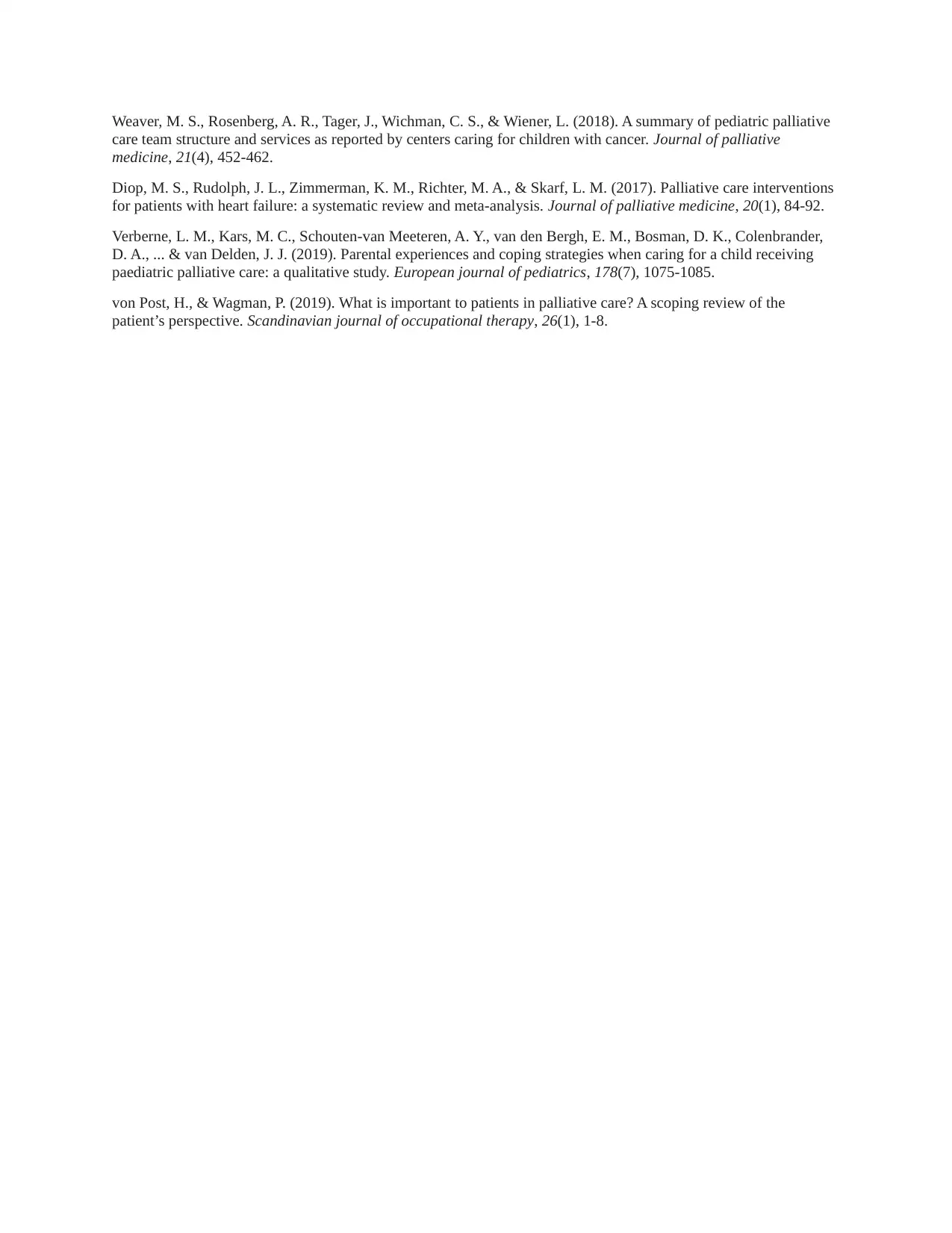
Weaver, M. S., Rosenberg, A. R., Tager, J., Wichman, C. S., & Wiener, L. (2018). A summary of pediatric palliative
care team structure and services as reported by centers caring for children with cancer. Journal of palliative
medicine, 21(4), 452-462.
Diop, M. S., Rudolph, J. L., Zimmerman, K. M., Richter, M. A., & Skarf, L. M. (2017). Palliative care interventions
for patients with heart failure: a systematic review and meta-analysis. Journal of palliative medicine, 20(1), 84-92.
Verberne, L. M., Kars, M. C., Schouten-van Meeteren, A. Y., van den Bergh, E. M., Bosman, D. K., Colenbrander,
D. A., ... & van Delden, J. J. (2019). Parental experiences and coping strategies when caring for a child receiving
paediatric palliative care: a qualitative study. European journal of pediatrics, 178(7), 1075-1085.
von Post, H., & Wagman, P. (2019). What is important to patients in palliative care? A scoping review of the
patient’s perspective. Scandinavian journal of occupational therapy, 26(1), 1-8.
care team structure and services as reported by centers caring for children with cancer. Journal of palliative
medicine, 21(4), 452-462.
Diop, M. S., Rudolph, J. L., Zimmerman, K. M., Richter, M. A., & Skarf, L. M. (2017). Palliative care interventions
for patients with heart failure: a systematic review and meta-analysis. Journal of palliative medicine, 20(1), 84-92.
Verberne, L. M., Kars, M. C., Schouten-van Meeteren, A. Y., van den Bergh, E. M., Bosman, D. K., Colenbrander,
D. A., ... & van Delden, J. J. (2019). Parental experiences and coping strategies when caring for a child receiving
paediatric palliative care: a qualitative study. European journal of pediatrics, 178(7), 1075-1085.
von Post, H., & Wagman, P. (2019). What is important to patients in palliative care? A scoping review of the
patient’s perspective. Scandinavian journal of occupational therapy, 26(1), 1-8.
1 out of 10
Related Documents
Your All-in-One AI-Powered Toolkit for Academic Success.
+13062052269
info@desklib.com
Available 24*7 on WhatsApp / Email
![[object Object]](/_next/static/media/star-bottom.7253800d.svg)
Unlock your academic potential
Copyright © 2020–2025 A2Z Services. All Rights Reserved. Developed and managed by ZUCOL.




